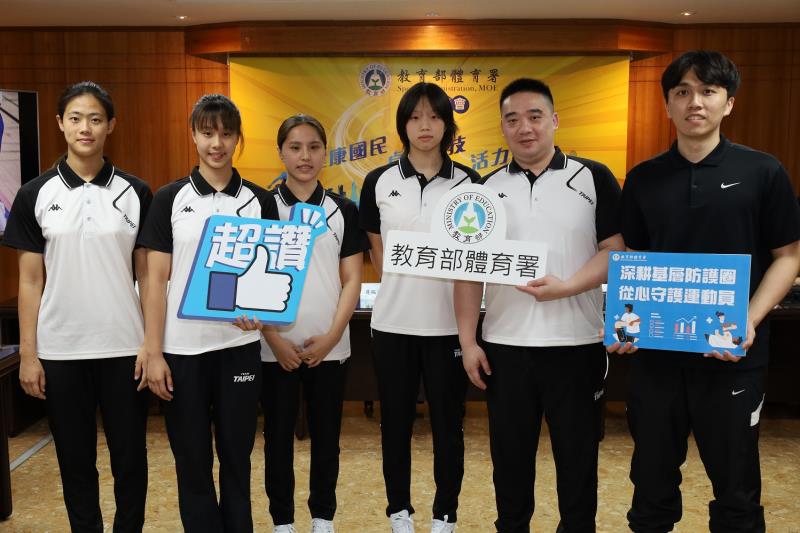A Decade of Building a Grassroots Sports Injury Prevention Network in Schools Dedicated to Safeguarding Student Athletes

The Sports Administration (SA) held a press conference on May 22 to present the achievements of the “Subsidy Program for Hiring of Athletic Trainers by Senior High Schools.” Initially launched as a pilot in the 2014 academic year, the program was formally implemented the following year. It has established a solid campus sports injury prevention system through the set up of seven regional support centers. The aim is to safeguard grassroots athletes and enhance the knowledge and awareness of injury prevention among teachers, coaches, and students. In the early stages, only four high schools participated in the pilot. By the 2024 academic year, the program had expanded to 180 schools, subsidizing 183 athletic trainers to assist student-athletes on campus. This growth has contributed to a complete care mechanism for nurturing athletic talent and instilled the importance of injury prevention at the grassroots level.
The SA emphasized that the program not only supports schools in building sports injury prevention mechanisms and connecting with athletic trainers, but also highlights the importance of integrating regional medical resources. Currently, 219 medical institutions nationwide participate in the "Green Channel" medical network, offering fast-track diagnosis and rehabilitation services to athletes. On average, 15,000 student-athletes benefit from this network each year, with over 3,000 treatment visits annually. Plans are underway to enlist new partners, aiming to shorten rehabilitation timeframes and improve recovery outcomes. The program has achieved notable success in education and awareness promotion. Nearly 200 educational seminars are held annually, with an average attendance of 11,000 participants. The program places great importance on cultivation of athletic trainers, holding at least 30 skill enhancement courses each year to upgrade professional capabilities and stay up to date with the latest knowledge in sports injury prevention.
Professor Hsu Mei-Chih of Kaohsiung Medical University’s Department of Sports Medicine highlighted the development of the “Athletic Injury Record System” since the program began. This digital platform enables on-campus athletic trainers to log in treatment records for student injuries, allowing real-time health monitoring and assessing the suitability of a return to training.
The program has seven regional support centers in partnership with universities known for their sports injury prevention and medical expertise: Taipei City, New Taipei City & Keelung Area – National Taiwan University, New Taipei Area – Fu Jen Catholic University, Taoyuan, Hsinchu, Miaoli Area – National Taiwan Sport University, Taichung, Changhua, Nantou Area – China Medical University, Yunlin, Chiayi, Tainan – National Cheng Kung University, Kaohsiung, Taitung, Pingtung Area – Kaohsiung Medical University, Yilan, Hualien – Tzu Chi University. Professor Lin Guan-Yin from National Taiwan University’s Department of Physical Therapy said that these centers organize educational workshops to improve understanding of sports nutrition, banned substances, and injury prevention. They also coordinate with doctors and professionals to provide school consultations and on-site support, ensuring comprehensive care both on and off the field and providing a strong support system for campus athletic trainers.
Coach Ke Jie-Fu and athletic trainer Cheng Chung-Hsiang of Taipei Municipal Song-Shan Senior High School’s swim team attended the event to share the importance of campus-based injury prevention. Coach Ke emphasized that swimming requires significant pre- and post-competition support from professional athletic trainers to help condition athletes’ muscles. Their team recently won first place in the high school girls’ division at the National High School Games, a success made possible by this support system. Trainer Cheng discussed his daily responsibilities, including preventive care before events and muscle relaxation during competitions, allowing athletes to stay focused and perform to their full potential.
The SA stated that over 160 athletic trainers are now working in schools across Taiwan, handling injury treatment, rehabilitation, and prevention. Athletic trainers offer personalized rehabilitation plans based on each sport’s demands, including joint mobility training, core strengthening, and proprioception training, ensuring athletes recover safely and return to competition quickly.
In recent years, local governments have also begun prioritizing injury prevention, forming sports injury prevention teams for large-scale national sporting events to provide on-site care. The SA will continue to promote injury prevention efforts in schools and strengthen cooperation with local governments; and encourage municipalities to customize their programs to school needs or local characteristics, promoting diverse and complete sports injury prevention programs and related measures, working together to build a complete sports medicine system and sports injury prevention network. The SA is committed to the mission: “Dedication to Injury Prevention, Boosting Team Combat Power,” nurturing grassroots athletes and ensuring the health and competition safety of athletes across Taiwan.




